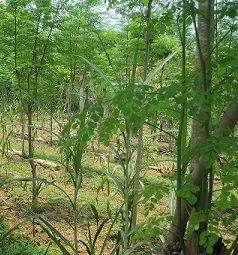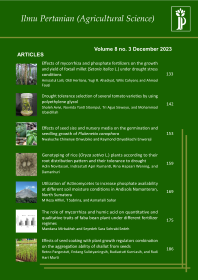
Physiological characteristics of two accessions of moringa (Moringa oleifera Lam.) at different planting sites in Madura
Catur Wasonowati(1), Endang Sulistyaningsih(2*), Didik Indradewa(3), Budiastuti Kurniasih(4)
(1) Study Program of Agroecotechnology, Faculty of Agriculture, Trunojoyo Madura University Jl. Raya Telang, Kamal, Bangkalan-Madura
(2) Department of Agronomy, Faculty of Agriculture Universitas Gadjah Mada Jln. Flora no. 1, Bulaksumur, Sleman, Yogyakarta 55281
(3) Department of Agronomy, Faculty of Agriculture Universitas Gadjah Mada Jln. Flora no. 1, Bulaksumur, Sleman, Yogyakarta 55281
(4) Department of Agronomy, Faculty of Agriculture Universitas Gadjah Mada Jln. Flora no. 1, Bulaksumur, Sleman, Yogyakarta 55281
(*) Corresponding Author
Abstract
Moringa plants grow in Sumenep with semi-intensive planting at the moor and several planting sites. Sumenep is one of the districts in Madura Island, which is categorized as a dry area based on the Oldeman climate classification. Based on the color of the leaf stalk, moringa plants growing in Sumenep area are categorized as green and purple moringa. The study aimed to examine the differences in physiological characteristics of two accession of moringa plants at different planting sites in Madura. The study was arranged in Oversite Sub-sampling Design with planting site as first factor consisting of Bluto with E5 climate type and Guluk-guluk with D3 climate type. Meanwhile, the second factor was the type of moringa consisting of moringa with green and purple leaf stalks. The results showed that the different planting sites represented the differences in environmental elements, which influenced the physiological characteristics of moringa plants. Based on the observation in September 2016, moringa plants with green stalks planted in Guluk-guluk had high ANR content. The stomatal opening on moringa leaves with green stalks was larger than that on moringa plants with purple stalks, whereas ANR content in green-stalked moringa was lower than in the purple-stalked ones. Meanwhile, in February 2017, the purple-stalked moringa plants planted at Bluto had the highest transpiration rate and proline content compared to the others.
Keywords
Full Text:
PDFReferences
Akunda, E., M. W. Akunda and D. Kumar. 1981. A simple technique for timing irrigation in coffee using cobalt chloride paper disks. Irrigation Science, 3 : 57-62.
Anni, I. A, E. Saptiningsih and S. Haryanti. 2013. Pengaruh naungan terhadap pertumbuhan dan produksi tanaman bawang daun (Allium fistulosum L.) di Bandungan, Jawa Tengah. Jurnal Biologi, 2 : 31-40.
Badan Pusat Statistik Kabupaten Sumenep. 2014. Sumenep dalam angka 2014. https://sumenepkab.bps.go.id/publication.html?
Barselia, A. W., M. Yasir, E. H. Prameisti, Y. Permanasari, H. L. Rizkia, N. L. P. S. Dewi, D. R. Sinaga, W. Busse, S. Ulbricht, M. P. Koentjoro and E. N. Prasetyo. 2014. Integrated study of Moringa oleifera as high potential commodity in the small island: A case study. Poteran Island, Sumenep. SIDI ITS Surabaya. Matec ITS, 1-9.
Bates, L. S., R. P. Waldren and I. D. Teare. 1973. Rapid determination of free proline for water stress studies. Plant and Soil Journal, 39 : 205-207.
Brandao, A. D. and L. Sodek. 2009. Nitrate uptake and metabolism by roots of soybean plants under oxygen deficiency. Brazilian Society of Plant Physiology, 21 : 13 - 23.
Chumark, P., P. Khunawat, Y. Sanvarinda, S. Phonrnchirasilp, P.N. Morales, L. Phivtong-ngam, P. Ratanachanong, S. Srisawat, K.S. Pongrapeporn. 2008. The in vitro and ex vivo antioxidant properties, hypolipidaemic and antiaherosleroticactivities of water extract Moringa oleifera Lamk leaves. Journal of Ethnopharmacology, 116 : 439-446.
Fischer, K. S. and S. Fukai. 2003. How rice responds to drought. Breeding rice for the drought-prone environment. 1st ed. Philippines : IRRI .
Haryanti, S. 2010. Jumlah dan distribusi stomata pada daun beberapa spesies tanaman dikotil dan monokotil. Buletin Anatomi dan Fisiologi, 13 : 21-28
Herrera A, M. D. Fernandez, and M. D. Taisma. 2000. Effect of drought and water relations in plant of Peperomia carnevalii. Annals of Botany, 86: 511-517.
Islami, T. and W. H. Utomo. 1995. Hubungan tanah, air dan tanaman. 1st ed. Semarang : IKIP Semarang Press.
Khaerana, M. Ghulamahdi, and E. D. Purwakusumah. 2008. Pengaruh cekaman kekeringan dan umur panen terhadap pertumbuhan dan kandungan xanthorrhizol temulawak ( Curcuma xanthorrhiza roxb .). Buletin Agronomi, 3 : 241–247.
Lakitan, B. 2018. Dasar-dasar fisiologi tumbuhan. 8th ed. Jakarta : PT. Raja Grafindo Persada.
Liu, F., Jensen and M. N. Andersen. 2004. Drought stress effect on carbohydrate in soybeans leaves and pods during early reproductive development: its implication in altering pod set. Field Crop Research, 86 : 1-13.
Luthfiyah, F. 2012. Potensi gizi daun kelor (Moringa oleifera) Nusa Tenggara Barat. Media Bina Ilmiah, 6 : 42-50.
Maestri, M. F. M. Da Matta, J. Regazzi, and R.S. Barros. 1995. Accumulation of proline and quaternary ammonium compounds in mature leaves of water stressed coffea plants (Coffea arabica and C. Canephora). Journal of Horticultural Science, 70 : 229-233.
Mahalleh, J. K., H. H. S. Abad, G. Nourmohammadi, F. Darvish, I. M. Haravan, and E. Valizadegan. 2011. Effect of super absorbent polymer (Tarawat A200) on forage yield and qualitative characters in corn under deficit irrigation condition in Khoy Zone (Northwest of Iran). Advances in Environmental Biology, 5:2579-2587.
Novenda, I. L and S. A. Nugroho. 2016. Analisis kandungan prolin tanaman kangkung (Ipomoea Reptana Poir), bayam (Amaranthus Spinosus), dan ketimun (Cucumis Sativus L.). Pancaran, 5 : 223-234.
Salisbury, F. B and C. W. Ross. 1995. Fisiologi tumbuhan. 1st ed. Bandung : Penerbit ITB, Bandung.
Article Metrics
Refbacks
- There are currently no refbacks.
Ilmu Pertanian (Agricultural Science) ISSN 0126-4214 (print), ISSN 2527-7162 (online) is published by Faculty of Agriculture Universitas Gadjah Mada collaboration with Perhimpunan Sarjana Pertanian Indonesia (PISPI) and licensed under a Creative Commons Attribution-ShareAlike 4.0 International License.













